Vol 4 No. 25 TROPIC LIGHTNING NEWS June 23, 1969
Index
ARVNs, 2nd Bde Join To Blast 72 NVA
By SP4 Art Brown
CU CHI - In a fiercely contested day-long battle ten miles
northwest of Cu Chi, the 2d Battalion, 12th Infantry combined forces with troops
from the 49th ARVN Regiment, 1st Battalion (Mechanized), 5th Infantry, and 2d
Battalion, 34th Armor to smash an enemy base camp, killing 72 of its defenders.
The action began when the 2d Battalion, 12th Infantry Warriors and
ARVN infantrymen were conducting search operations in the area. Everything
was going well, and the combined elements were turning up stores of enemy
supplies.
“The ARVNs were finding things right and left that we could have
overlooked,” related Captain Paul Allen of Orlando, Fla.
THE INFANTRYMEN were moving into a densely wooded area for further
searching when the men were caught in a Viet Cong attempted ambush. “We were
pinned down by heavy AK and automatic weapons fire,” said Specialist 4 Dennis
Lyons of Martin, S.D.
“Superior firepower and helicopter gunships got us out of
the kill zone,” said Private First Class Bob Cox of Pierce, Neb. “They
got down close and let Charlie have it.”
The friendly ground troops pulled back, allowing artillery to pound
the enemy positions. The Air Force followed the artillery bombardment with
air strikes.
Following the afternoon air strikes, the combined force troops
stormed into the enemy complex only to meet more heavy resistance. The
soldiers returned with blazing fire.
THE BATTLE slowed at dark and the infantry and armor combined to
make a night laager.
At first light, the united force swept into and through the enemy
camp with no resistance. The fleeing enemy left behind 72 of his dead
along with 40 AK-47 rifles, two light machine guns, and seven RPG launchers.
Other supplies, ammunition, and pieces of equipment were destroyed
in place. Numerous enemy bunkers were leveled.
“The ARVN advisor, Sergeant First Class James H. Wood, and his
radio-telephone operator, Specialist 4 Leroy Weidnes did an outstanding job of
coordinating the Vietnamese troops with ours,” said Lieutenant Colonel John
E. Mann of Seat Pleasant, Maryland. “The combined effort really hit the
enemy hard. They lost a lot of men, equipment and weapons.”
Warriors Snip Snipers
CU CHI - While on a security mission with the 65th Engineer
Battalion, infantrymen from the 2d Battalion, 12th Infantry, ran into enemy
snipers, killing 14.
The incident occurred four miles northwest of Trang Bang. The
engineers were working to improve resupply routes in the area when the fire
began.
“They started to fire at us with AK-47s from three or four
scattered positions about 250 meters away,” said Captain John K. Taft of
Youngstown, Ohio. “We suppressed their fire with small arms and machine
guns.”
Artillery from nearby Fire Support Bases Pershing and Stuart laid a
barrage of deadly fire into each enemy position. The 105mm and eight-inch
guns along with air power blasted the enemy from their hidden fortifications.
When the hail of steel stopped, the Warriors pushed through the
area reinforced by Alpha Company.
There was no resistance. Destroyed by air and artillery were four
AK-47s and two RPG launchers. One additional AK-47 was found intact.
 |
WHAT A WAY TO GO - Specialist 4 Gerald Johnson of St. Louis, Mo., can verify that there must be a better way to look for Charlie. The 2d Brigade grenadier was on a search-and-destroy mission near Fire Support Base Jackson when Wolfhound photographer Specialist 4 R. B. Williams caught this sticky situation. |
Bobcats, ARVNs, Phantoms Stun VC
CU CHI - In a day of enemy contact so close to Cu Chi base camp
that Air Force Phantom jets making their strike passes thundered directly over
division headquarters, elements of the 1st Battalion (Mechanized), 5th Infantry,
fought a battle of strange twists, killing 17 Viet Cong soldiers and detaining
seven suspects.
Early in the day, while sweeping through a heavily booby-trapped
area one and a half miles west of Cu Chi, an ARVN unit working with the Bobcat
infantrymen discovered two Viet Cong in a hole. Arresting them without a
fight, the Vietnamese soldiers learned that a small Viet Cong force was hidden
in the immediate vicinity.
AFTER FOUR AIR strikes hit in the area, the Bobcats swept on foot
while their armored personnel carriers provided flank security.
Specialist 4 Steve Stubblefield of Conoga Park, Calif., unknowingly
stood on a camouflaged trap door over a spider hole containing four VC. He
paused a second to consider where his next step should go, then moved on.
Apparently the tension had been too much for the occupants of the hole.
As Stubblefield stepped off the trap door, it sprang open, creating
a disturbance that caused him to whirl around and find a pair of eyes staring at
him. Simultaneously, the underground warrior shouted “Chieu Hoi!”
Startled, Stubblefield leveled his M-16 at the suspect and said,
“Okay, come on out of that hole.” Stubblefield and the rest of his
squad watched him climb out.
AS IF ONE suspect making his presence known in such a striking
manner were not enough, two other men and a woman followed the first out of the
hole. The group turned in three AK-47 rifles and a supply of ammunition.
Stubblefield’s platoon leader, First Lieutenant Michael C.
Meilstrip of Bay City, Mich., who was directly behind him, praised his
cool-headedness. “The way he handled the situation was great.
Because he exercised caution and restraint, we were able to detain four Viet
Cong suspects.”
During the rest of the day, the Tropic Lightning troops encountered
no opposition. The day’s activities accounted for 17 enemy killed, seven
detainees, six AK-47 rifles, one K-54 pistol, one .45 caliber pistol, and
several enemy documents.
 |
| BEING LOADED DOWN with 28 pounds of radio can make river crossing a hazardous venture. But this Wolfhound soldier from the 2d Battalion, 27th Infantry, continues to drive on. (PHOTO BY SP4 R. B. WILLIAMS) |
Page 2 TROPIC LIGHTNING NEWS June 23, 1969
Decorated
| BRONZE STAR FOR HEROISM | |
|
CPT Jon W. Blades III, Co A, 4th Bn, 23d Inf CPT Bud R. Brown, Co A, 1st Bn, 5th Inf 1LT James T. Carter, Co B, 1st Bn, 5th Inf 1LT Peter F. Mohan, Co A, 2d Bn, 22d Inf 1LT William A. Hendrickson, Co B, 2d Bn, 22d Inf 1LT Jerry A. Ashburn, Co D, 2d Bn, 12th Inf 2LT Lamond R. Mills, Co B, 2d Bn, 22d Inf SSG Joseph C. Urkshus, Co C, 1st Bn, 5th Inf SSG Bobby Q. Brock, Co A, 1st Bn, 5th Inf SSG James H. Shope, HHC, 4th Bn, 23d Inf SSG Richard Trullinger, Co C, 2d Bn, 22d Inf SSG Donald W. Bass, Co C, 2d Bn, 22d Inf SSG William L. Merrifield, HHC, 1st Bn, 5th Inf SSG Richard L. Hautekeete, HHC, 1st Bn, 5th Inf SP4 Dayle Stapleton, Co C, 4th Bn, 23d Inf SP4 Michael G. Reece, Co C, 4th Bn, 23d Inf SP4 Charles E. Ward, Co B, 4th Bn, 23d Inf SP4 Kenneth D. Alford, Co B, 4th Bn, 23d Inf SP4 Glenn N. Matsushita, Co A, 2d Bn, 14th Inf SP4 William Lamonica, HHC, 1st Bn, 5th Inf SP4 David G. Canant, Co A, 1st Bn, 5th Inf SP4 Walter P. Stamper, C Trp, 3d Sqdn, 4th Cav SP4 David Strong, Co C, 3d Bn, 22d Inf SP4 Larry E. Byrd, Co A, 2d Bn, 22d Inf SP4 Richard C. Olson, Co D, 1st Bn, 27th Inf SP4 Dennis Berryman, Co B, 4th Bn, 23d Inf SP4 Gordon L. Schmitz, C Trp, 3d Sqdn, 4th Cav |
SP4 Luis A. Padilla, Co A, 2d Bn, 34th Armor SP4 Bobby W. Thomas, Co A, 1st Bn, 5th Inf SP4 Fred C. Forehand, Co F, 75th Inf SP4 Douglas R. Miller, HHC, 3d Bn, 22d Inf SP4 Veryl Hershour, Co B, 4th Bn, 23d Inf SP4 George F. Martinez, Co D, 2d Bn, 12th Inf SP4 John Juve, Co B, 1st Bn, 27th Inf SP4 Wayne A. Lounsberry, Co B, 1st Bn, 5th Iif SP4 Michael Reznick, Co B, 1st Bn, 5th Inf SP4 William R. McNelly, Co F, 75th Inf SP4 Ronald C. Carey, Co B, 2d Bn, 12th Inf SP4 Howard W. Armstrong, Co B, 1st Bn, 27th Inf SP4 Edward E. Chapman, Co D, 2d Bn, 12th Inf SP4 Ralph W. Buchanan, Co B, 2d Bn, 12th Inf SP4 William W. Cushman. Co D. 2d Bn. 12th Inf SP4 Doye A. Kersey, Co A, 1st Bn, 5th Inf SP4 Clarence W. Pace, Co B, 2d Bn, 22d Inf SP4 Larry Hillyard, Co A, 2d Bn, 14th Inf SP4 Dean A. Baker, Co A,. 2d Bn, 14th Inf SP4 Harless Belcher, Co C, 2d Bn, 22d Inf SP4 Larry E. Byrd, Co A, 2d Bn, 22d Inf PFC Jimmey B. McGowen, A Btry, 7th Bn, 11th Arty PFC Kenneth D. Goodwin, Co B, 4th Bn, 23d Inf PFC Paul T. Weiss, Co B, 1st Bn, 5th Inf PFC William A. Tesauro, Co D, 2d Bn, 12th Inf PFC Pedro Olivo, Co B, 1st Bn, 5th Inf |
Army Cares for Its Own; AER Drive Opens in July
The annual Army Emergency Relief and Army Relief Society Joint Fund
campaign will get under way June 15 and continue through August 16, 1969.
Every man in organic and non-divisional support units will have an opportunity
to contribute and help the Army take care of its own.
Army Emergency Relief is available to all members and retired
members of the Army and their dependents. AER came into existence in 1942
when it was realized that some provision must be made to assist members of the
rapidly expanding army when they or their families were confronted with
financial emergencies for which no appropriated funds were available.
The Army Relief Society (ARS) is closely associated with AER,
though it dates from 1900 when it was established to assist needy widows and
orphans of Regular Army personnel. It provides scholarships and other aids
to eligible dependents.
Contributions to the ARS are strictly voluntary, and no set goal
has been set by higher headquarters. Last year II Field Force units
contributed $226,000 of the total $1,084,000 collected in that year, and the
need for emergency assistance is expected to continue at about the same level.
Assistance is available to personnel everywhere with the Tropic
Lightning Division authorized to make grants or interest-free loans in amounts
up to $250. A recent and typical case involved a soldier whose wallet
containing the money he intended to send his dependents was lost.
AER gave the man enough money to ease the strain on his
family until his allotments could take effect.
Generally emergency aid falls into one of the following eight
categories: Privation of dependents, non-receipt of pay, allotments or
allowances, emergency travel, rent, loss of personal funds, funeral expenses,
medical, dental and hospital expenses and various confidential matters.
Contributions are accepted in cash, check or money order, and
checks and money orders should be made payable to AER Section 19099.
‘Routine’ Eagle Flight Gives Golden Dragons Busy Day
CU CHI - One morning recently the Golden Dragons of Delta Company,
2d Battalion, 4th Infantry, took off on what appeared to be a typical eagle
flight.
They hit their landing zone and started moving toward the
objective. Suddenly they were called back to where they had been set down.
GUNSHIPS HAD spotted some Viet Cong with weapons near Bao Cong.
The Dragons loaded up again and headed for the area where the Stingers of the
116th Assault Helicopter Company were keeping the enemy occupied.
The troopers reached the landing zone again and immediately started
sweeping into the area where the action was taking place.
The Viet Cong were shooting back, but Delta Company commander
Captain Thomas Waldera of Algona, Iowa, explained the situation this way, “It
was a rather one-sided firefight - with our troops doing nearly all the
shooting.”
THE FIREFIGHT lasted about 30 minutes, with Delta Company and the
Stingers finally subduing their prey.
In sweeping the area, the Dragons counted 11 Viet Cong dead.
They also found a grenade, four AK-47 rifles, 2 SKS carbines and ten pounds of
documents.
In the firefight the Golden Dragons had only one man wounded.
A soldier stepped on an anti-personnel mine and received shrapnel wounds.
Waldera remarked that the entire area of the fight was heavily
booby trapped and mined with anti-personnel devices and trip wire-initiated
charges.
Hey Gang, 30-Day R&R Now Open!
One complaint about R&R is that it is too soon over.
Those of you who have been thinking about extending your tour now have a chance
to spend thirty days somewhere east of Suez.
The Re-Up office is now authorized to grant a 30-day leave for a
six-month extension, a leave that can be taken in any R&R location, Guam,
Okinawa, or, for those inured to foreign climes, CONUS.
To qualify, extend to serve six months after your return from
leave, secure the approval of your company and battalion, and get all details
from the Division Re-Up office or your re-enlistment NCO.
The TROPIC LIGHTNING NEWS is an authorized publication of the 25th Infantry Division. It is published weekly for all division units in the Republic of Vietnam by the Information Office, 25th Infantry Division, APO San Francisco 96225. Army News Features, Army Photo Features, Armed Forces Press Service and Armed Forces News Bureau material are used. Views and opinions expressed are not necessarily those of the Department of the Army. Printed in Tokyo, Japan, by Pacific Stars and Stripes.
MG Ellis W. Williamson . . . . Commanding General
MAJ John C. Fairbank . . . . . Information Officer
1LT John C. Burns . . . . . . . . Officer-in-Charge
SP4 Robert Imler . . . . . . . . . . Editor
SP5 Charles Withrow . . . . . . Assistant Editor
SP4 Ralph Novack . . . . . . . . Production Supervisor
BATTALION CORRESPONDENTS
| SGT
Jon Anderson PFC Ken Baron SP4 Arthur Brown PFC Larry Goodson SP4 Richard Huhta PFC Phil Jackson PFC Craig Sampson |
1/5 1/8 2/12 2/12 2/14 2/27 2/27 |
SP5
Doug Elliott PFC Steve Duncan SP4 Dave DeMauro PFC Dan Stone SGT Roger Welt SP4 Pete Freeman |
2/34 3/4 3/22 4/9 4/23 7/11 |
Page 3 TROPIC LIGHTNING NEWS June 23, 1969
ARVN-Aided MEDCAPS Draw More Vietnamese
By Sp4 Al Hibler
DAU TIENG - Third Brigade medics have taken on a new ally - the
Vietnamese medic, who now works side by side with his American counterpart on
medical civil action programs (MEDCAPS).
“These Regional and Popular Forces medics are usually very
good,” said Captain Willie Black, Jr., civil affairs officer for the 2d
Battalion (Mechanized), 22d Infantry, “and the local people seem more
responsive when treated by the RF and PF medics.”
The Vietnamese and American medics share the workload on each
MEDCAP. Changing bandages, diagnosing symptoms, prescribing medicine and
giving injections are their usual tasks.
The allied soldiers usually treat more than 100 people at
each village stop.
“We have to use interpreters to find out what’s bothering a
patient, which makes an American medic’s job just that much more difficult,”
said Specialist 5 Mike Vaughn of Phoenix, Ariz., “but our Vietnamese medical
counterparts have no language barrier and can find out what’s actually a
patient’s problem.”
A recent MEDCAP at An Phu near Dau Tieng showed the kind of
reception the allied medics usually receive. “The MEDCAP started out
with an average number of patients,” said Vaughn, “but when the word got
around that we had Vietnamese medics treating the people, we drew overflow
crowds.”
The Triple Deuce MEDCAP team treated more than 200 villagers at An
Phu and is prepared for more of the same size crowds as they tour the Dau Tieng
area.
Black, of Columbus, Ga., explained the complete scope of the 3d
Brigade’s medical effort. “The use of Vietnamese medics allows us to
give better service to the people, but at the same time their presence builds
faith in the South Vietnamese government, which we must have before we hope to
win the war.”
3 Triple Deuce Companies Overrun NVA Base Camp
DAU TIENG - A joint three-company force from the 2d Battalion
(Mechanized), 22d Infantry, killed 29 North Vietnamese Army soldiers recently
after overrunning an enemy base camp in the area known as the Crescent, three
miles west of Dau Tieng.
The attack followed a devastating B-52 strike and marked the third
battle in as many days for the Triple Deuce infantrymen of Tropic Lightning’s
3d Brigade.
After the heavy bombing strike, the companies pulled their armored
personnel carriers on line and blasted the jungle with a barrage of .50 caliber
machinegun fire while artillery from the Dau Tieng base camp pounded the same
area.
With the mechanized infantrymen dismounted and leading tracks
through heavy underbrush and thickly vined trees, the 3d Brigade soldiers began
uncovering fortified bunkers, destroying all those that survived the air strike.
Ground elements discovered freshly made bunkers as they pushed past
the strike zone. “We were just about on top of them when all hell broke
loose,” said Sergeant Lon Oakley of Dallas, Tex.
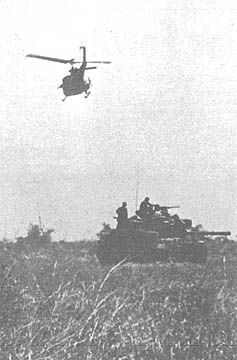 |
ON GUARD - A tank from the 2d Battalion, 34th Armor Dreadnoughts securing a landing zone for the eagle flight extraction of a company of the 2d Battalion, 14th Infantry Golden Dragons, prepares to make a sweep north of Cu Chi. (PHOTO BY SP5 DOUG ELLIOTT) |
Dreadnaughts Open Monsoon Operations Base at Emory
By SP5 Doug Elliott
CU CHI - The Tropic Lightning’s 2d Battalion, 34th Armor, in
preparation for the approaching monsoons, is quickly shifting gears for the
change of operations.
The Dreadnaught armormen, under the direction of Lieutenant Colonel
Duane R. Tague of Terre Haute, Ind., are building a new fire support base three
miles from Cu Chi.
THE NEW BASE of operations, known as Emory, will provide tight
security for a nearby highway, the Phu Cuong and Ba Bep bridges, and offer a
ready reaction force to any area east of Cu Chi.
Fire Support Base Emory, deployed on high ground, will eliminate
the problem of vehicles sinking into the soft mud of the lowlands. The
rainy season will not hamper the tanks from deploying to critical areas from
their base.
In the construction, Rome plows from the 65th Engineer Battalion
graded the land and pushed into position the outer berm. Engineer stakes
were laid out for the positioning of perimeter bunkers.
Then like a swarm of locusts, Dreadnaught tank crewmen, recon
platoon members and support personnel arrived on the scene carrying sandbags and
shovels. Under a broiling sun the bunkers slowly began to take shape.
With only a little groaning, the fire support base grew under the straining
backs of the men.
MATERIALS ARRIVED for heavy construction, piping, and defense.
Rock was brought in to build a secure roadbed. By the fourth day of
construction, the base was ready to use for operations.
A tank-infantry combination has proved to be a tremendous team
against the enemy in Vietnam. And a joint operation between the two has
all the mobility and heavy firepower of armor and the thoroughness of the ground
search.
Nothing gets by the team’s notice, and nothing can stand up to
its firepower.
IN A RECENT example, 2d Battalion, 34th Armor tanks joined
infantrymen from the 2d Battalion, 14th Infantry in a five-day operation north
of Cu Chi.
The Tropic Lightning 2d Brigade troops searched the thickly-wooded
area for rocket sites, caches, enemy forces and unexploded munitions.
One cache of seven 107mm rockets was uncovered; in the same
location the Dreadnaught tank force had made a huge cache haul in February.
Numerous mines, booby traps, tunnel complexes and dud rounds were
also destroyed.
Golden Dragons Co Gets Thirty Medals
By SP4 Richard Huhta
CU CHI - Bravo Company, 2d Battalion, 14th Infantry awarded thirty
medals to individuals during ceremonies held at the Phu Cuong Bridge. The
awards were the result of four recent encounters with the Viet Cong.
The first of the important contacts was in the swamps of the
Oriental River when the Fire Brigade Golden Dragons were heliborne into the area
early in the evening. They made contact with a reinforced VC squad and
Bravo Company gained a body count of five in that encounter.
Their second meeting with the enemy was southeast of Duc
Hoa when a point man sighted a group of Viet Cong with weapons. He was
wounded by enemy fire.
Gunships were immediately called in and the Golden Dragons caught
their prey. In the fracas they killed five Viet Cong and confiscated three
automatic rifles with ammunition and one RPG launcher with rockets.
As a result of the firefight, Staff Sergeant Denny Maron, West
Covina, Calif., received the Silver Star for his heroism in pursuit of the enemy
while under intense fire from their position.
While at Fire Support Base Ayres, west of Bau Tri, the 2d Brigade
Golden Dragons came under a heavy mortar attack by the Viet Cong. Soon
after they had to stand off a heavy ground attack by the enemy. In that
battle the Tropic Lightning infantrymen killed 10 Viet Cong.
In the last of the battles with the Viet Cong, the Golden Dragons
came under enemy fire while the outgoing and the incoming battalion commanders
were still overhead in choppers - in full view of the action.
Bravo Company, under the command of Captain David J. Boyle of
Malden, Mass., was awarded a Silver Star, 11 Bronze Stars with the “V”
device, three Bronze Stars, 10 Purple Hearts, one Army Commendation Medal, one
ARCOM Achievement Award and three ARCOMs with the “V” device.
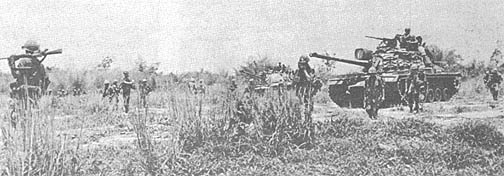 |
| A force of 2d Battalion, 14th Infantry Warriors and 2d Battalion, 34th Armor Dreadnaughts prepares to move out on a sweep. (PHOTO BY SP5 DOUG ELLIOTT) |
Page 4-5 TROPIC LIGHTNING NEWS June 23, 1969
MEDCAPS Bring Health to Ap Ninh Hung
Popular Forces, Tomahawks Adopt Village
Feature By SGT Roger Welt
TAY NINH - Villagers of Ap Ninh Hung, a hamlet of 2,000 people
located six miles east of Tay Ninh City, are getting a new and healthy outlook
because of a civic action program conducted by Vietnamese Popular Forces and
Tomahawks of the 4th Battalion (Mechanized), 23rd Infantry. The PFs and
Tomahawks are trying in every way to make life a little easier for the war-torn
villagers.
The commanding officer of the 4/23, Lieutenant Colonel G.E. Taylor
of Shelby, N.C., assigned several of his men to work on projects that will
better the village - among them furnishing the local, barren school yard with
badly needed recreation equipment, planting trees, improving roads, and
bettering the drainage system for the rainy season. The battalion surgeon
also holds a regular “sick call” for the villagers.
“We haven’t forgotten the other hamlets in our operational
area,” said Captain James Norman of Long Beach, Calif., the officer in charge
of the new civic action program. “Daily Medical Civic Action Programs
are being carried out in different locations so all the local people will
benefit.”
The Tomahawks work closely with the local Vietnamese Popular
Forces. “These are some of the finest soldiers I’ve seen,” said
Taylor. “They deserve our support and we’re giving it to them in every
possible way.”
The Vietnamese and Americans are working side by side in all phases
of the new civic action program. Little by little the battle-scarred area
is turning into a safe and healthy place to live.
 |
| WINDY - Children on the outskirts of Tay Ninh City run after leaflets being distributed by the 4th Battalion, 23d Infantry. The leaflets’ messages range from telling where and when the next MEDCAP is going to be held to encouraging the civilians to turn in enemy weapons. |
 |
HANDSHAKE - Lieutenant Colonel G. E. Taylor of Shelby, N.C., commanding officer of the 4/23, shakes hands with a small boy during civic action operations. |
| DIAGNOSIS - The case is diagnosed and the prescription filled. The villagers look forward to each visit of the 4/23 doctor. To a lot of them it means a new life, one free of disease. |
 |
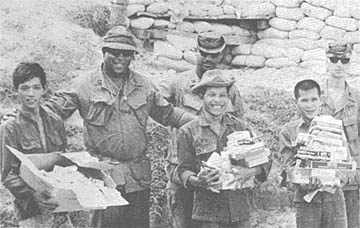 |
GOODIES - A small token for a job well done. The Tomahawks gave a PF outpost a large box of sundries for doing a good job. The outpost, four miles north of Tay Ninh City, has demonstrated outstanding performance in its daily operations. |
| THE VILLAGERS of Ap Ninh Hung, six miles east of Tay Ninh City, wait their turn to see the battalion surgeon, Major Al Prieto of Colombia, South America. Major Prieto visits the hamlet at least three times a week. |
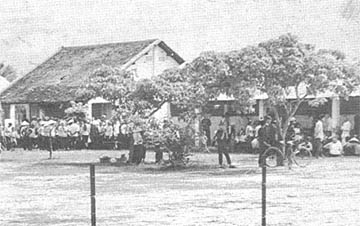 |
 |
PHAM VAN NGO, a member of a local PF outpost, displays a road mine he found while sweeping Highway 22. The Tomahawks work closely with local Vietnamese soldiers. Captain James Norman of Long Beach, Calif., and Sergeant First Class Ronald Carter of Detroit, flank the soldier. |
| CHECK-UP - Major Al Prieto checks out a bewildered youngster. The doctor treated over 250 patients in three and a half hours at the small hamlet of Ap Ninh Hung, six miles east of Tay Ninh City. |
 |
 |
A YOUNG POPULAR FORCES soldier cleans his 60mm mortar. He has been trained by the Tomahawks and has quickly learned to handle the mortar like a pro. |
| A SMALL PATRIOT holds a picture of President Nguyen Van Thieu. The PFs and the 4/23 have taken this boy’s hamlet under their protective wing. Support for the government of Vietnam is one of the benefits of the program. |
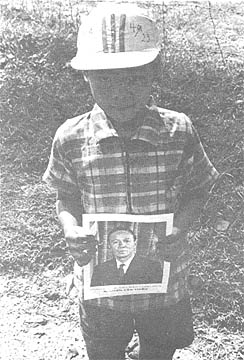 |
Page 6 TROPIC LIGHTNING NEWS June 23, 1969
Educational Exchange at Work in Dau Tieng
DAU TIENG - What do knowledge-seeking soldiers from the 3d Brigade
have in common with young Vietnamese students from a local high school in Dau
Tieng?
Would you believe Mondays, Wednesdays and Fridays? On each of
the three weekdays, both groups are busily studying each other’s language.
At the Dinh Thanh High School in Dau Tieng village,
Specialist 4 Don Cummings from the 3d Brigade Civil Affairs Section, leads his
Vietnamese class through vocabulary drills, sentence structure outlines and then
a written test or two.
Back at the American base camp, a young Vietnamese nurse can be
found in a similar situation, directing her class of American officers and
enlisted men in the finer points of Vietnamese.
The principal at the local high school felt an English class taught
by an American would be more meaningful to the students, and brought his request
to the brigade’s S-5. “It has proved to be a very good idea,”
explained Cummings, of Lansing, Mich., who has held his three-hour,
three-time-each-week class for the last six months. “It is very
impressive to see the dramatic progress the kids have made here.”
Cummings is not out of place heading his class of interested
students. The 22-year-old soldier was studying to become a science
instructor before entering the Army.
The English course is based on two texts obtained from the United
States Information Agency in Saigon. Cummings, a stickler on grammar and
rhetoric, works late many nights stenciling written tests that come often for
his students. “The kids are eager and receptive - they really pick up
complicated words. I give a lot of tests and they always do amazingly
well.”
The teacher-soldier studied Vietnamese before beginning his tour of
duty here. “There’s a lot of give and take in my classes,” said
Cummings. “I try to speak as much Vietnamese as possible during class
and they respond by speaking English as much as possible.”
At the 3d Brigade Education Center, Miss Dao Thi Gai conducts one
hour Vietnamese classes three times a week. Miss Gai, better known as Kim to her
students, is a nurse at the brigade’s medical facility.
Two years ago, when Kim was 17 years old, doctors at Bravo Company,
25th Medical Battalion, performed an operation, pulling a-jagged piece of
shrapnel from her hip. While recuperating in one of the wards at the
medical company, her friendly smile and quick mind won the hearts of the unit
and she stayed on, learning to be a nurse and acting as an interpreter for
Vietnamese patients.
Kim’s class for soldiers here is still in the growing stages.
“It’s very much like a language lab in schools back in the States,”
observed First Lieutenant Kevin Walters of Bethpage, N.Y. “Right now
we’re concentrating on learning basic expressions and forming our
pronunciation.”
The 3d Brigade soldiers are in the first of five phases outlined by
a USARV educational program. Each phase consists of a 20-hour block of
instruction which is proving “interesting and an awful lot of fun,”
according to Specialist 5 Jack Anderson of Claremont, Calif.
For both groups, the language classes are more than just an
educational exercise. Each is an attempt for better communication, which
promotes better understanding and friendship between peoples.
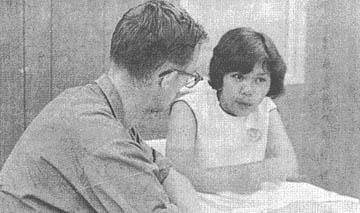 |
CONFERENCE - in this international teachers conference, the problems of teaching Vietnamese and English are discussed. |
| WHERE’S THE REGISTRAR? - Kim has no problem keeping her students’ interest. The Vietnamese nurse conducts classes three times each week. (PHOTO BY SP5 RICK ADAMS) |
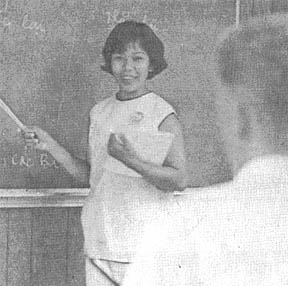 |
| GOIN’ BACK TO JACKSON - After a day on a sweep near Fire Support Base Jackson, this sure-footed Wolfhound makes his way “home” along a rice paddy berm. (PHOTO BY SP4 R. B. WILLIAMS) |  |
Deuces and RFs: A Tough Hand
DAU TIENG - Deuces were wild, and four North Vietnamese Army
soldiers were dealt losing hands during a recent combined
reconnaissance-in-force mission six miles south of Dau Tieng.
The combined force of mechanized infantry from Bravo Company, 2d
Battalion (Mechanized), 22d Infantry, and Vietnamese soldiers from Kiem Hanh
District’s Regional Forces were searching for enemy cache sites and possible
staging areas in the Boi Loi Woods.
The regional forces unit scored the first success of the operation,
uncovering six bunkers and killing three NVA in a brief firefight. Three
AK-47 assault rifles were captured during the encounter.
Bravo Company, working west of the RF element, uncovered several
bunkers housing five RPG-7 rounds, one RPG booster, 400 rounds of .50 caliber
ammunition and one rifle grenade.
Later that same afternoon, Bravo Company observed and engaged an
unknown-sized enemy element 300 feet east of their position.
The NVA soldiers, dressed in blue uniforms, were moving south.
They were engaged with small arms fire, resulting in one NVA killed. Near
the same area, Triple Deuce infantrymen found 15 bunkers and a kitchen complete
with pots and pans. All of the bunkers had eight to 10 feet of tunnel
leading from them.
“It’s combined operations like this that give us a chance to
see how effective the RF soldiers can be,” commented Captain Jack Johnston of
Missoula, Mont., Bravo Company commander. “They are fine troops,
excellent at uncovering caches and very responsive when they get in contact with
the enemy.”
Page 7 TROPIC LIGHTNING NEWS June 23, 1969
A Play in Three Acts
Regulars Star in ‘Crook Story’
Story and Photos
By Sp4 Dave DeMauro
TAY NINH - Preplanned supporting fire and expert co-ordination of
all available firepower were the key to success at Fire Support Base Crook,
where 402 North Vietnamese Army soldiers fell dead during three successive
nights of ground attacks. The outpost was defended by men of the 3d
Battalion, 22d Infantry.
The battalion executive officer, Major Joseph Hacia of
Wethersfield, Conn., called in artillery, helicopter gunships, and tactical air strikes
precisely where they were needed.
RAPIDLY MOVING from his tactical operations center to the berm line
and scrambling up and down the tower, Hacia pinpointed the targets and placed
his supporting fires right where they counted. The onrushing NVA were cut
down before they had a chance to enter Crook’s wire. At no time during
the three ground attacks did the NVA penetrate the defensive perimeter.
While dodging bullets from six .51 caliber machine gun positions,
Major John Bode of Albuquerque, N.M., marked prime targets for Air Force fighter
jets as fast as Hacia radioed them to him. Each time Bode dove in to
launch his spotter rockets; his Bronco spotter plane was ringed with red tracers
spurting from the enemy machine guns.
“I’m going to have to work on these .51s for awhile,” said
Bode over his radio. Within moments, Bode roared down directly at the
enemy machinegun emplacements and marked them for the jets to rake with their
40mm cannons. Once the guns were quieted, Bode went back to marking
targets around Crook’s perimeter.
CAPTAIN LARRY Thomas of Camp Hill, Penn., scurried from bunker to
bunker to organize the Regulars’ Bravo Company as mortars and rockets slammed
into the fire support base. Every man performed to perfection while
cutting down the onrushing NVA.
“My men did a fabulous job,” said Thomas. “Each man
fought as if he were the only one defending the perimeter, which is why the
enemy never penetrated our berm line.”
Charging NVA swarmed against Crook like bees buzzing into their
hive. But this “hive” was sealed off with a protective ring of
artillery fire. Specialist 4 Harry Mills of Salisbury, Md., co-ordinated
with Hacia and zeroed in the guns of Alpha Battery, 7th Battalion, 11th Field
Artillery, stationed at Crook. Artillery rounds and shrapnel slammed
directly into the faces of the enemy as they ran against the base.
MILLS GRABBED his radio and scrambled up the ladder at Crook during
the brunt of each attack. Even while his vantage point was under fire from
RPGs and 75mm recoilless rifles, Mills kept sighting the targets and radioing
the necessary corrections.
Fire Support Base Crook stood the test of three brutal assaults.
Its defenders were prepared.
“We invite the enemy to try and take any of our bases,” said
Hacia. “We’ve got what it takes to defeat him no matter what the
circumstances, and as long as he continues to carry on his futile effort, we are
ready to cope with him.”
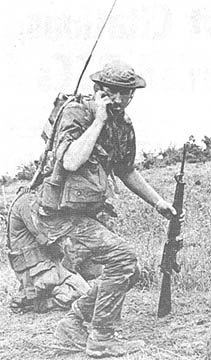 |
SEND THE WORD - Private First Class Jack Robey radios that the enemy is entrenched to his front, throwing hand grenades. The recon platoon helped sweep the battlefield around Crook after the first two nights of fighting. |
| GENERAL ANALYSIS - Surveying the situation at Fire Support Base Crook is 25th Division Commanding General Ellis W. Williamson. General Williamson is flanked by Regular Battalion Commander Robert D. Carmichael. Sergeant Major Howard Brosseau of Highland Falls, N.Y., is in the background. |
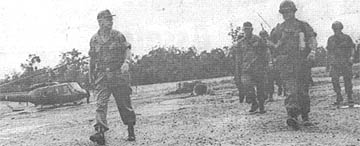 |
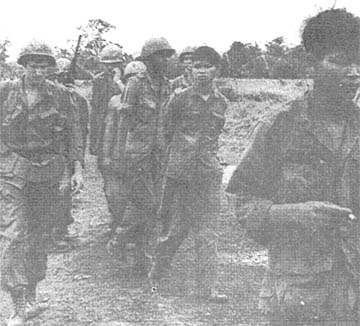 |
LUCKY? - This NVA soldier could be considered one of the lucky ones, one of the few lucky ones. Four hundred and two of his comrades didn’t live past the three days of fighting at Crook. |
| QUESTION AND ANSWER PERIOD - A frightened and battle-weary North Vietnamese soldier gives his account of the battle of Fire Support Base Crook. The young soldier’s words are being taken down by a Kit Carson scout. Sergeant First Class Donald Neal of Columbus, Go., comforted the soldier as he was detained by Bravo Company of the 3d Battalion, 22d Infantry. Neal speaks fluent Vietnamese, which came in very handy in the aftermath of the Crook battle. |
 |
 |
| MOVING OUT to sweep the area of the Regulars’ greatest victory, two alert riflemen stalk across the formerly NVA-infested turf. All during the early-morning hours, the NVA thundered against Crook’s impenetrable barriers of fire and wire. |
Page 8 TROPIC LIGHTNING NEWS June 23, 1969
Five Battalions Get Unit Citations;
Two Soldiers Are Awarded DSCs
CU CHI - Five Tropic Lightning Battalions were awarded the
Presidential Unit Citation and two Tropic Lightning soldiers were awarded the
Distinguished Service Cross by General Creighton Abrams, Commanding General,
MACV, in ceremonies in the Division’s Cu Chi base Camp.
The battalions cited were the 2d Battalion, 77th Artillery, 2d
Battalion, 12th Infantry, 2d and 3d Battalions, 22d Infantry, and the 2d
Battalion, 34th Armor.
AWARDED THE Distinguished Service Cross were 1LT Andres Gutierrez
of Co C, 1st Battalion, 27th Infantry and Private First Class Donald E. Evans of
B Troop, 3d Squadron, 4th Cavalry.
1LT Andres Gutierrez distinguished himself by exceptionally
valorous actions on February 23, 1969 during a rocket, mortar, and ground
assault on the Dau Tieng base camp by two NVA battalions reinforced with sapper
elements. Gutierrez organized a reaction force and led it to a point in
the perimeter that was under heavy enemy pressure.
Spotting three NVA preparing to fire an RPG into a bunker, he
killed them with his pistol. During the battle he continually exposed
himself to the enemy fire to rescue and treat the wounded and supply his men
with ammunition.
PFC EVANS distinguished himself during a reconnaissance-in-force
mission in the Boi Loi Woods when his troop came under intense fire from an
enemy force in well-concealed, fortified bunkers. As the troop advanced on
the bunkers, it was caught in a cross fire. Disregarding his own safety,
Evans assaulted a bunker and killed its five occupants. When the troop
received heavy fire from another bunker, Evans again ran forward and silenced
the position. Later he voluntarily remained behind as his troop withdrew
to permit the use of artillery.
The battalions were decorated for their part in the battle of Soui
Tre, believed to be the largest single action of the Vietnam war.
The battle of Soui Tre began at dawn, March 21, 1967, as the elite
272d Main Force Viet Cong Regiment surrounded the tiny fire support base 30
kilometers north of Tay Ninh City. In two hours of human wave assaults on
the entire perimeter, the VC Regiment penetrated in three places, driving the
defending artillery men back to the second defensive position around their guns.
BY 8 O’CLOCK the situation was bleak. All beehive rounds
had been exhausted, the artillery men were now doing double duty as infantrymen,
and the only ammunition remaining was a pile of high explosive rounds fast being
fired into the incoming enemy.
“It was the closest thing to the late, late show I have ever
seen,” said one officer. “It was the cavalry coming to the rescue
...” It was in fact the 2d Battalion (Mechanized) and 3d Battalion of
the 22d Infantry, followed by the 2d Battalion, 34th Armor, thundering out of
the woodline using all available fire power to cut down the enemy.
Air strikes were being called in 50 meters from the position as
Tropic Lightning soldiers cut through the enemy from behind, firing with every
weapon in reach. By 10:45 the Battle of Soui Tre was over, and 647 VC lay
dead.
| PARADE - left to right, Tropic Lightning Chief of Staff Colonel Robert L. Fair, General Creighton Abrams and Major General Ellis W. Williamson review the color guards on parade at ceremonies in which five battalions were awarded Presidential Unit Citations and two individuals received Distinguished Service Crosses. |
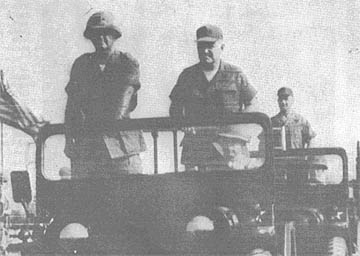 |
Dau Tieng SGT Supervises Base Camp Liquid Assets
DAU TIENG - If someone told you to “go jump in a lake” or
implied that you were all wet, you’d have a good reason to take offense.
But one Tropic Lightning soldier from the 3rd Brigade takes all such comments in
stride with a big, sun-tanned smile.
Sergeant Ron Davenport from Creswell, N.C., holds the job that must
be the envy of any division soldier who has sweated his own shower and eaten
more than his share of Vietnam’s ever-present dust.
DAVENPORT IS the lifeguard at the big, French-built swimming pool
that serves all 3d Brigade units at the Dau Tieng base camp. “I know it
sounds like it has to be the easiest job in the Army, but it does take a lot of
work - honest,” smiled Davenport.
The 21-year-old sergeant didn’t always have his “easy” job.
He spent six months in the field as a squad leader with Delta Company, 1st
Battalion, 27th Infantry Wolfhounds before taking over his swimming pool duties.
“The old lifeguard was DEROSing and they were going to have to
close the pool if they couldn’t find a qualified replacement,” explained
Davenport. A qualified replacement was someone with a senior lifesaving
certificate.
Davenport was just the man. He had earned his lifesaving
certificate through a Red Cross water safety program before entering the Army,
and had worked as a professional lifeguard at Nag’s Head along the Atlantic
Coast.
“I REMEMBER HOW I felt when my company would come in from the
field and we’d all get a chance to use the pool,” Davenport recalled. “So I’m doing my best to keep the swimming area in perfect running condition
so those guys can really enjoy themselves.”
Perfect running condition means daily checks of the complex pumping
system and tight control of chlorine content. Armed with mops,
scrubbers and lots cf detergent, Davenport cleans the shower area first thing
each morning. The biggest cleaning problem is falling leaves from nearby
rubber trees that add to the beauty of the area but keep Davenport hopping.
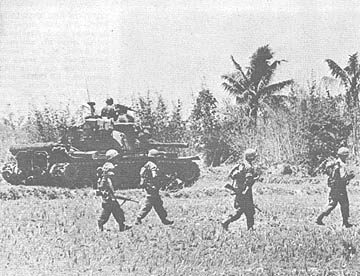 |
DOUBLE THREAT - A tank from Alpha Company, 2d Battalion, 34th Armor and troops from Charlie Company, 2d Battalion, 12th Infantry Warriors move toward a hedgerow containing an NVA force. (PHOTO BY SGT JAN ANDERSON) |
Thanks to
Karl Karlgaard, 2nd Bn., 27th Inf (Wolfhounds), for sharing this issue,
Kirk Ramsey, 2nd Bn., 14th Inf. for creating this page.
This page last modified 8-12-2004
©2004 25th Infantry Division Association. All rights reserved.